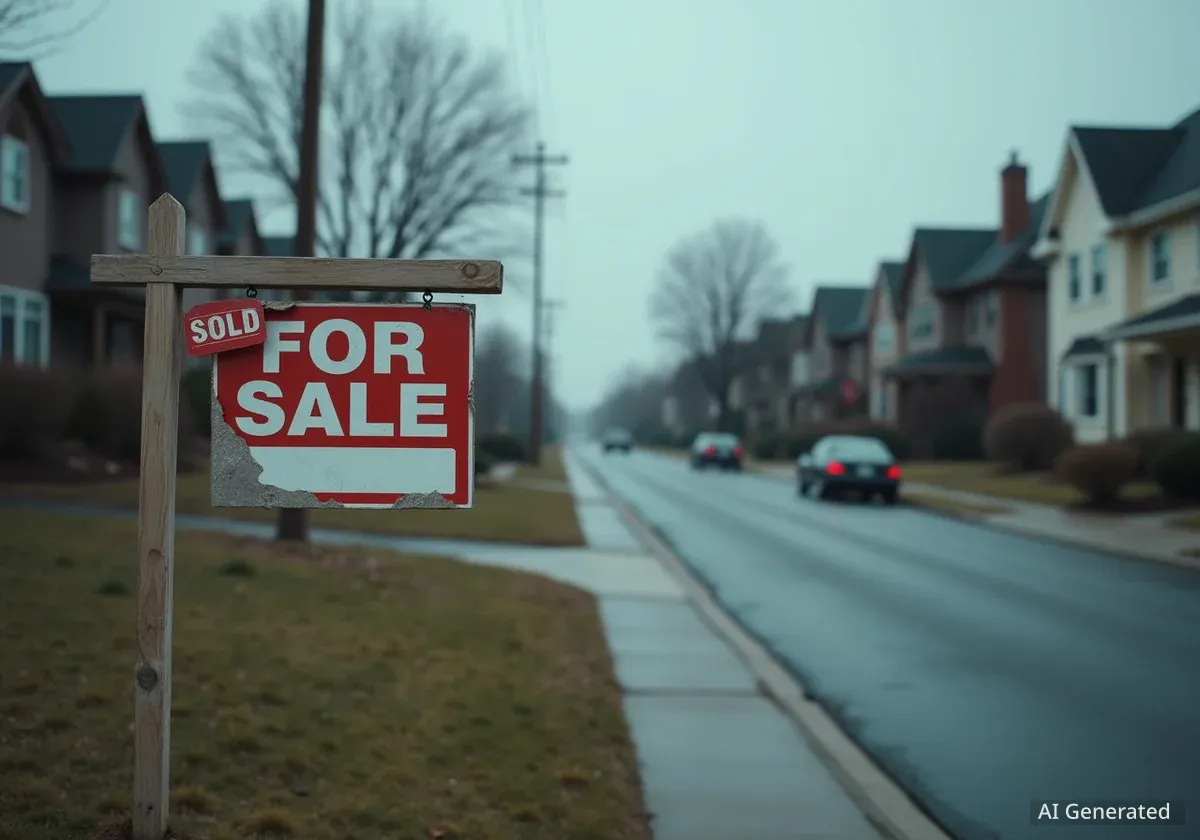The number of homes changing hands across the United States has fallen to its lowest level in at least 30 years, signaling a profound stagnation in the housing market. Data shows that for every 1,000 homes, only 28 were sold in the first nine months of the year, a historic low that reflects deep-seated hesitation from both buyers and sellers.
This slowdown is driven by a unique economic situation where homeowners are locked into low mortgage rates, making them reluctant to sell. At the same time, potential buyers are sidelined by high borrowing costs and persistent affordability challenges, creating a market gridlock with few signs of easing.
Key Takeaways
- The U.S. home turnover rate is the lowest recorded since at least the 1990s, with only 28 sales per 1,000 homes this year.
- A significant factor is the "rate-lock" effect, where over 70% of homeowners have mortgage rates below 5% and are unwilling to re-enter the market at current higher rates.
- Buyers are facing challenges with affordability, as mortgage rates hover above 6%, alongside concerns about the broader economy.
- Major metropolitan areas like New York City, Los Angeles, and San Francisco are experiencing the lowest sales activity in the nation.
A Market Grinds to a Halt
The American dream of homeownership is facing a new reality as the market for existing homes has become exceptionally quiet. An analysis of public records and Multiple Listing Service (MLS) data reveals a stark decline in transactions. The current turnover rate of just 28 sales per 1,000 homes is an unprecedented figure in modern real estate history.
This slowdown isn't a sudden event but the culmination of economic pressures building over the past year. While there was some optimism following the Federal Reserve's rate cut in September, its impact on the housing sector has been minimal. The market remains stuck, with inventory low and sales volumes continuing to shrink.
By the Numbers
The national turnover rate of 28 sales per 1,000 homes is a clear indicator of the market's condition. This figure represents the pace of sales from January through September, confirming a sustained period of low activity.
The 'Golden Handcuffs' Effect on Sellers
One of the primary forces behind the market freeze is a phenomenon known as the "rate-lock" effect. A vast majority of current homeowners in the U.S. financed their properties during a period of historically low interest rates. According to data from Redfin, more than 70% of mortgage borrowers have a rate below 5%.
These homeowners are now in a difficult position. Selling their current home would mean giving up a favorable mortgage, only to finance a new purchase at a much higher rate. With the 30-year fixed mortgage rate recently reported at around 6.17% by Freddie Mac, the financial incentive to stay put is overwhelming for many.
This reluctance to sell has severely limited the supply of existing homes on the market, further contributing to the overall slowdown. Homeowners are effectively wearing 'golden handcuffs'—bound by the excellent financial terms of their current mortgage.
Buyers Sidelined by Affordability Crisis
While sellers are hesitant, buyers are facing their own set of significant hurdles. The primary obstacle is affordability. The combination of high home prices and elevated mortgage rates has pushed monthly payments out of reach for many prospective buyers.
Beyond the direct costs of purchasing a home, broader economic anxieties are also playing a role. Concerns about potential tariffs and signs of a weakening U.S. job market are causing buyers to pause their search. This combination of financial strain and economic uncertainty has dampened demand considerably.
"When both sides hesitate, sales naturally fall to historic lows," explained Chen Zhao, the head of economics research at Redfin, summarizing the current market dynamic.
Major Cities See Fewest Transactions
The housing market slowdown is a national trend, but it is felt most acutely in some of the country's largest and most expensive metropolitan areas. These regions are experiencing the lowest turnover rates on record.
Where Sales Have Slowed the Most
An examination of city-level data shows where the market is most stagnant:
- New York City: Leads the nation with the lowest turnover, recording just 10.3 sales for every 1,000 homes.
- Los Angeles: Also saw extremely low activity, with fewer than 15 sales per 1,000 homes.
- San Francisco: Similar to Los Angeles, the Bay Area hub recorded fewer than 15 sales per 1,000 homes.
These cities, known for their high property values, are particularly sensitive to shifts in mortgage rates and buyer affordability, making them bellwethers for the national housing market's health.
No Quick Rebound Expected
Looking ahead, most housing market analysts do not anticipate a significant drop in mortgage rates anytime soon. This suggests that the current gridlock could persist for the foreseeable future.
Forecasts from industry experts paint a picture of continued high borrowing costs. Redfin has projected that mortgage rates will likely remain close to 7% through the rest of 2025. Similarly, Zillow expects the 30-year fixed rate to hover in the 6% to 7% range through the end of next year.
Without a substantial improvement in affordability or a major shift in seller sentiment, the U.S. housing market is likely to remain in this period of historically low activity, challenging both those looking to buy and those considering a move.





